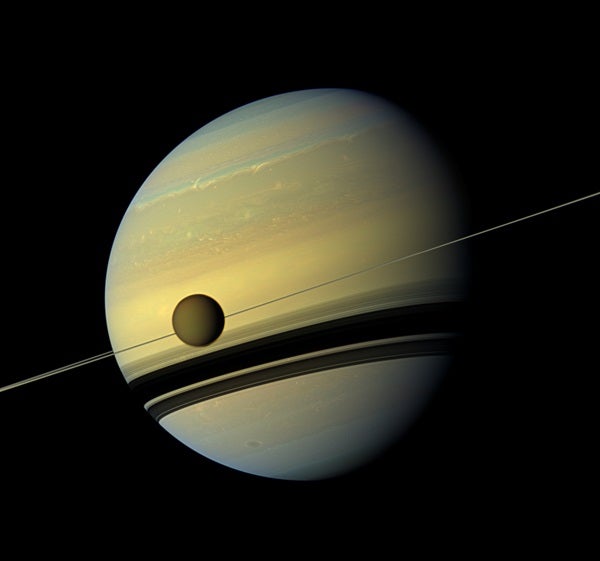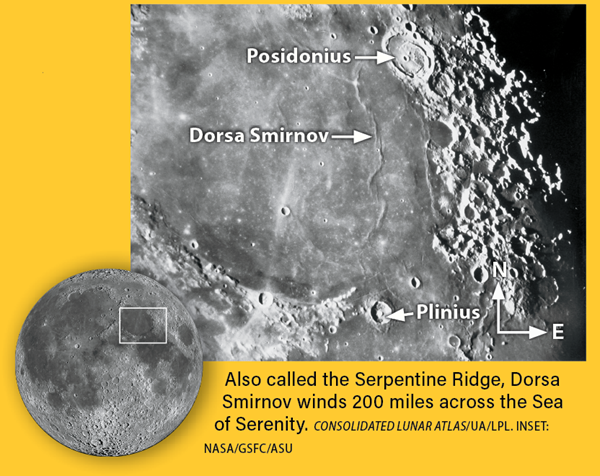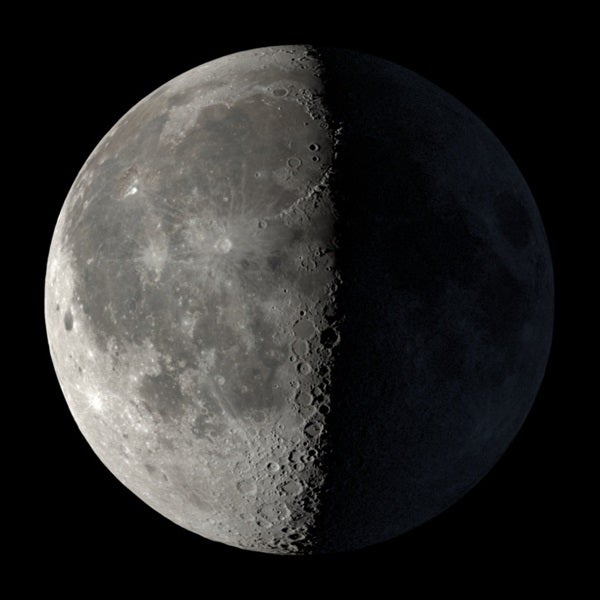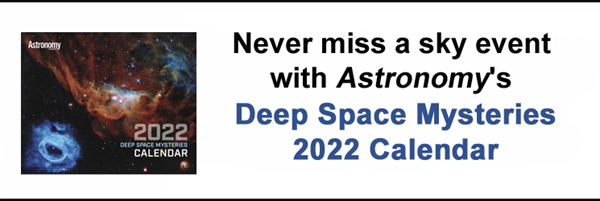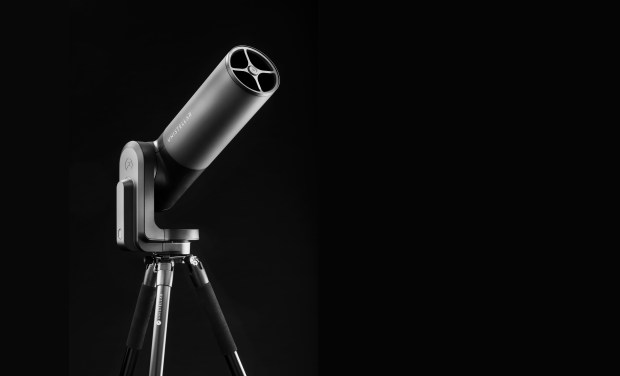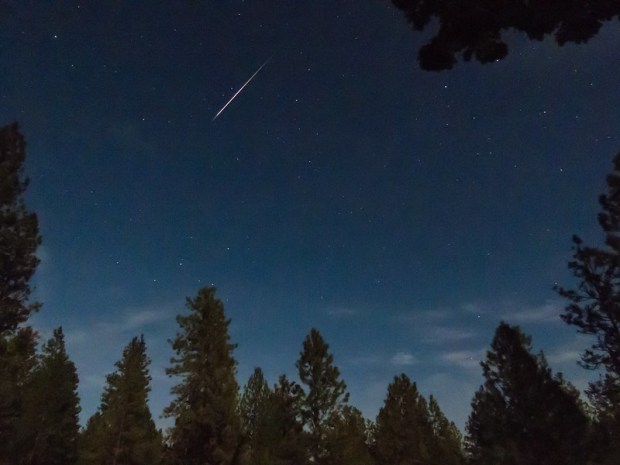Friday, September 24
Uranus is the most distant planet you can spot with the naked eye. And tonight presents a great timed challenge for anyone with a dark observing sight and a clear view of the eastern horizon.
Our Moon passed 1.3° south of Uranus at noon EDT, while both were still below the horizon. After the Sun has set, Uranus rises around 8:30 P.M. local time, followed just 25 minutes later by the bright Moon. Those 25 minutes are the best time to try spotting the ice giant without optical aid, although it may be somewhat masked by the thick, turbulent air that sits close to the horizon. Even if you can’t find Uranus with the naked eye, binoculars or a small telescope will let you easily capture its magnitude 5.7 glow. You’ll find the planet 12° below (southeast of) 2nd-magnitude Hamal in Aries.
Just before 9 P.M. local time, the Moon rises 6° east of Uranus, already having pulled away along the ecliptic since noon. Even so, our satellite is still close enough to likely wash out the faint planet’s light, at least to the naked eye. But the apparent separation between the two will increase each night this week even as the Moon wanes further, growing fainter and less intrusive in the sky. So, if you aren’t quite ready to test your observing mettle, just wait a few days and you’ll have much better luck tracking down Uranus with or without optical aid. (See the entry for Thursday!) Plus, you’ll have all night to find it, rather than only the short window available tonight. The higher the planet rises, the easier it will be to see as the air grows thinner and steadier toward the zenith.
Sunrise: 6:50 A.M.
Sunset: 6:53 P.M.
Moonrise: 8:55 P.M.
Moonset: 10:20 A.M.
Moon Phase: Waning gibbous (87%)
*Times for sunrise, sunset, moonrise, and moonset are given in local time from 40° N 90° W. The Moon’s illumination is given at 12 P.M. local time from the same location.
Saturday, September 25
As the Moon starts to wane, the Sun is now setting over the Sea of Serenity. This paints the lunar landscape with reverse lighting, where sunlight is coming from the opposite direction as when the Moon is waxing.
It’s a unique chance to view familiar features looking almost alien. Tonight after moonrise, point your telescope to the lunar east (west in the sky) to find the 200-mile-long (322 kilometers) Serpentine Ridge, also called Dorsa Smirnov. This complex feature was formed as areas just below the surface, which is covered in dark lava, collided, causing the terrain above them to buckle and wrinkle.
To the ridge’s upper right (northeast) is Posidonius — a crater stretching nearly 60 miles (95 km) across. This oval patch houses a wealth of detail, including a sinuous rille, which are features planetary scientists think were formed by flows of lava or perhaps collapsed lava tubes. The one inside Posidonius snakes across the crater floor for more than 80 miles (130 km).
Sunrise: 6:51 A.M.
Sunset: 6:52 P.M.
Moonrise: 9:24 P.M.
Moonset: 11:21 A.M.
Moon Phase: Waning gibbous (80%)
Sunday, September 26
The Moon reaches the farthest point from Earth in its orbit, known as apogee, at 5:44 P.M. EDT. At that time, our satellite will sit 251,432 miles (404,641 km) away.
Asteroid 89 Julia, a 90-mile-wide (145 km) main-belt world, is skimming through Aquarius the Water-bearer this month. Tonight, its 9th-magnitude glow sits just over 2° north of the gorgeous globular cluster M2, which shines with an integrated brightness of magnitude 6.5. You should be able to easily capture both in the same binocular field, although a telescope will be best for viewing M2 in a bit more detail. This celestial cotton ball contains some 150,000 stars and, although it’s second on Charles Messier’s list, was not discovered by the French comet hunter. Instead, Jean-Dominique Maraldi found it in 1746 — 14 years to the day before Messier did.
Mercury is stationary at midnight EDT tonight. The solar system’s innermost planet had been traveling toward the southeast, or prograde. Now, it will make a tight turnaround in Virgo and begin moving northwest, or retrograde, coming to another halt and pivoting again on October 17.
Sunrise: 6:52 A.M.
Sunset: 6:50 P.M.
Moonrise: 9:58 P.M.
Moonset: 12:12 P.M.
Moon Phase: Waning gibbous (72%)
Monday, September 27
Saturn’s largest moon, Titan, sits due south of the planet today. After dark, swing a telescope toward the ringed planet to see it wreathed in several small moons. Titan is the brightest at magnitude 8.5, sitting some 1′ from the planet. Tenth-magnitude Dione and Tethys sit in a neat line to Saturn’s east, with Dione farthest out. Enceladus, a dim magnitude 12, hovers just off the rings’ northeast. Can you spot it?
The yellow-hued disk of Saturn itself stretches about 18″ across, with its rings spanning a larger 41″ or so. Those rings are tilted 19° to our line of sight, letting us see their northern face. The outermost ring is called Ring A, and is a bit darker than the closer-in Ring B. A dark gap — the 2,980-mile-wide (4,800 km) Cassini division — separates the two rings.
Sunrise: 6:53 A.M.
Sunset: 6:48 P.M.
Moonrise: 10:37 P.M.
Moonset: 1:21 P.M.
Moon Phase: Waning gibbous (63%)
Tuesday, September 28
As the Moon approaches Last Quarter this evening at 9:57 P.M. EDT, the best time to view it will actually be early this morning before sunrise. At that time, our satellite will still be a little more than 50 percent lit, hovering between the horns of Taurus the Bull.
You can enjoy the Moon in many ways with little or no magnification. Getting a close-in view with binoculars or a telescope, though, will let you better study features along the terminator, which divides lunar night from day. This morning, several round, rugged craters are visible along this line of shadow in the lunar south, while larger, darker seas dominate its northwestern side (which appears east in our sky).
As long as you’re in the area of the sky, Taurus is also home to two famous and easy-to-spot star clusters: the Hyades and the Pleiades (M45). Both look best at low magnification — and in fact, many observers enjoy them using no observing tools at all. Your telescope’s low-power finder scope is also an excellent way to take in these young star clusters. The Hyades, which are dusted across Taurus’ nose near bright red Aldebaran, are some 625 million years old. The Pleiades are much younger: only about 100,000 million years old.
Sunrise: 6:54 A.M.
Sunset: 6:47 P.M.
Moonrise: 11:24 P.M.
Moonset: 2:17 P.M.
Moon Phase: Waning gibbous (54%)
Wednesday, September 29
Venus is located in Libra tonight, setting in the west about two hours after the Sun. But that’s still plenty of time for evening observers to catch it — and in fact, it’ll be the first thing to pop out in the twilight sky, given its bright magnitude of –4.2.
Once darkness falls, you’ll see that the planet is located between and below Zubenhakrabi (Gamma [γ] Librae) and brighter Zubenelgenubi (Alpha [α] Librae). Together with Zubenesh (Beta [β] Librae), the four form a diamond in the sky. Venus also sits roughly 0.5° from magnitude 4.5 Iota (ι) Librae, far outshining this star.
Zoom in on Venus with a telescope and you’ll see the planet is just 63 percent lit, spanning 19″ in apparent size on the sky. It currently sits about 0.9 astronomical unit (AU) from Earth, where 1 AU is the average Earth-Sun distance of 93 million miles (150 million km).
Sunrise: 6:55 A.M.
Sunset: 6:45 P.M.
Moonrise: —
Moonset: 3:09 P.M.
Moon Phase: Waning crescent (44%)
Thursday, September 30
Mercury passes 1.7° south of Spica at 11 A.M. EDT. Of course, the Sun is high in the sky by then, so step outside right after sunset to catch them this evening. You’ll want to be quick, though — just 10 minutes after sunset, Mercury is only 1.5° high, with Spica not yet visible to the naked eye, still roughly 1.7° to the planet’s north. Once you’re sure the Sun has set, try finding them with binoculars or a small telescope, hugging the western horizon. Don’t pull out your optics until the Sun is completely gone from the sky, however, to avoid accidentally damaging your eyes.
Even if you aren’t able to catch Mercury before it sets, there’s another planet you’ll want to hunt down tonight: Uranus. Rising around 8 P.M. local time, the ice giant is up all night and glows at magnitude 5.7. That’s bright enough for keen-eyed observers to spot from a dark observing site, or for anyone to easily snag in binoculars or any telescope.
Tonight, Uranus sits less than 0.5° northeast of magnitude 5.8 Omicron (ο) Arietis. If you’re able to use high magnification, you’ll see the planet’s 4″-wide disk, which often appears a flat, pale blue. It’s also sitting just 16″ from a close pair of 12th-magnitude field stars.
Sunrise: 6:56 A.M.
Sunset: 6:43 P.M.
Moonrise: 12:17 A.M.
Moonset: 3:54 P.M.
Moon Phase: Waning crescent (35%)
Friday, October 1
Asteroid (40) Harmonia reaches opposition at 3 P.M. EDT. This space rock spans about 66 miles (107 km) across and was discovered in 1856. It circles the Sun, along with its main-belt brethren, between Mars and Jupiter and takes about 3.4 years to complete a single orbit.
Today, you’ll find it in Cetus the Whale. Because it’s at opposition, Harmonia will rise around sunset and set around sunrise, so you can opt to view it either in the morning or the evening. The crescent Moon won’t interfere. Harmonia glows softly at magnitude 9.5 — well within the range of binoculars or a small scope. As the constellation is rising, you’ll find Harmonia about 8.8° directly above (northwest of) 3rd-magnitude Eta (η) Ceti and 7.7° to the left (northeast) of 3rd magnitude Iota Ceti. Zoom in on the asteroid, and you’ll see it’s only about 0.1° from a slightly brighter (magnitude 7) field star, HIP 3385.
Sunrise: 6:57 A.M.
Sunset: 6:42 P.M.
Moonrise: 1:18 A.M.
Moonset: 4:34 P.M.
Moon Phase: Waning crescent (25%)

